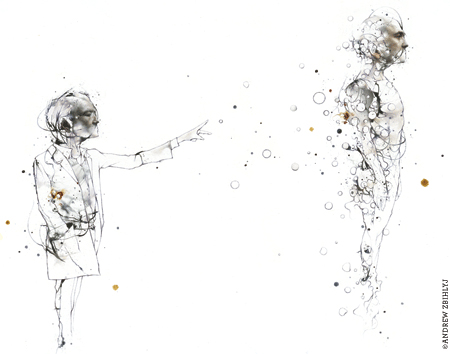
Man-made organisms have become a reality.
Here’s how policymakers can start dealing with it.
By Art Caplan
I first met Craig Venter at a meeting held at the National Academy of Sciences in Washington, on a rather bleak January afternoon in 1997. I was there to address the ethics of genetic engineering of humans. Venter was there to talk about the genetic engineering of microbes. After listening to his talk, I understood that both were of equal importance in using the rapidly growing knowledge of genomics to benefit humanity.
Venter was trying to figure out what genes could be deleted in a relatively simple viral genome without causing the virus to die—what today is called minimal genomics. But after his lecture he told me that he was keenly interested in building a genome that could guide a virus or bacteria, from which the genes had been completely removed, back to life—a field now referred to as synthetic genomics. Since the genes that control viruses and bacteria are simpler than those that govern the cells in our bodies, Venter believed it should be possible to understand them and even manipulate them to make new microbes. Such novel organisms might secrete useful drugs, food-like substances, or fuels, or even have an appetite for pollutants like the oil that has recently fouled the Gulf of Mexico.
This sounded both exciting and ethically challenging. Who would own and control the techniques of minimal and synthetic genomics? Would some people find the creation of life, even in microbial form, immoral? What if someone intent on doing harm got his hands on these techniques? And even if synthetic microbes were designed to do good, could Venter or anyone else promise that there would be no leakage or escape that could create environmental havoc?
Venter concurred that these issues needed consideration. He agreed to fund a working group at Penn’s Center for Bioethics through a foundation he had just created, knowing he would have to let us write whatever we wanted. In 1999 this group produced a paper, “Ethical considerations in synthesizing a minimal genome,” which was published in Science and stands as a landmark of the value of early collaboration between cutting-edge scientists and ethicists. We called upon policymakers to pay attention to this emerging area of microbiology, to establish patent policy, to consider protections against terrorists and accidents, and to engage with the religious community about the prospect of creating new life forms.
Thus I and my colleagues at the Center—plus those working-group members who had left Penn to establish world-class bioethics programs at Stanford and Emory—were well prepared to address the ethical concerns raised in May when Venter, Daniel Gibson, and a team at the Venter Institute announced that they had created the world’s first synthetic bacteria using an artificial set of genes and the hollowed-out cell of another bacteria. They did not create life from absolute scratch, but they did succeed in creating life from non-living elements, using genetic instructions that they designed themselves.
Sadly, while the ethics work we had done more than a decade ago had anticipated the key concerns that accompanied this announcement, little had happened on the policy front. Without a bug in hand, governments around the world had done almost nothing to prepare for the emergence of synthetic biology.
Given the history of genetically modified plants—whose pollen and seeds have in some cases wound up in all sorts of places where they are not wanted, irritating farmers and worrying many environmentalists—it is imperative that a strong, transparent, universal, and enforceable set of policies be put in place to control both research involving synthetic viruses and bacteria and their commercial manufacture and release. There are some standards in place in the US for dealing with the bioengineering of organisms, but many agencies (including the FDA, EPA, and USDA) have roles to play, which can make regulatory authority hard to determine. Canada and the European Union have regulations as well, but they are not consistent with US requirements. And none of these regulations were written with the synthesis of novel viruses and bacteria in mind.
Let me offer four general principles that may help exercise control over the products of synthetic biology.
First, since national security and public health must have top ethical priority, it may be appropriate to implement controls over the publication of scientific details, the location of laboratories, and who is permitted to train in them.
Second, to ensure the responsible handling of synthetic life, all synthetic organisms should be marked or branded in some way so as to make it easy to distinguish them from natural lifeforms. Venter’s team inserted several DNA “watermarks” into their novel bacteria, using the genetic code to spell out words and sentences.
Third, to ensure the safety of the environment from accidents, every synthetic life form ought to have some limit on its lifespan engineered into its genome.
Finally, in order to accelerate the good that synthetic genomics can do, researchers’ access to the key techniques of synthetic biology should not be hindered by expensive licensing fees or restrictive patents.
These ideas may help tamp down some of the practical concerns about making new life forms. But they do not address the philosophical, religious, and metaphysical anxiety that some may feel either about creating life or demonstrating that life is something humans can control and understand.
There are those who see too much hubris in “playing god” when scientists create bacteria. The challenge, though, is in the “playing” part of the allegation. If scientists can work with ethicists and policymakers—whose attention they now have—to provide a sound regulatory framework for synthetic biology, much of this concern will evaporate.
It may be harder to calm the fears of those who see the beginning of the end of the mystery of life as a threat to their worldview. Are they right? Should we feel a bit less in awe of the swarming life around us, or the fact of our own lives, because scientists understand how to get a man-made set of genes to fire up the shell of a bacteria? I think not.
The value of life is not imperiled or cheapened by coming to understand how it works any more than an airplane, computer, or satellite is less worthy of admiration—even awe—just because human beings know how they work and how to make them. Dignity and value can and do inhere in what scientists know, craft, and make, as well as in what they do not understand. Life, as Venter’s group has shown, can be made. More forms and types will be made in the future. It is up to us to see if we can succeed at the task of making new forms of life for humane and noble purposes.
Arthur L. Caplan is the Sidney D. Caplan Professor of Bioethics and the director of the Center for Bioethics.




